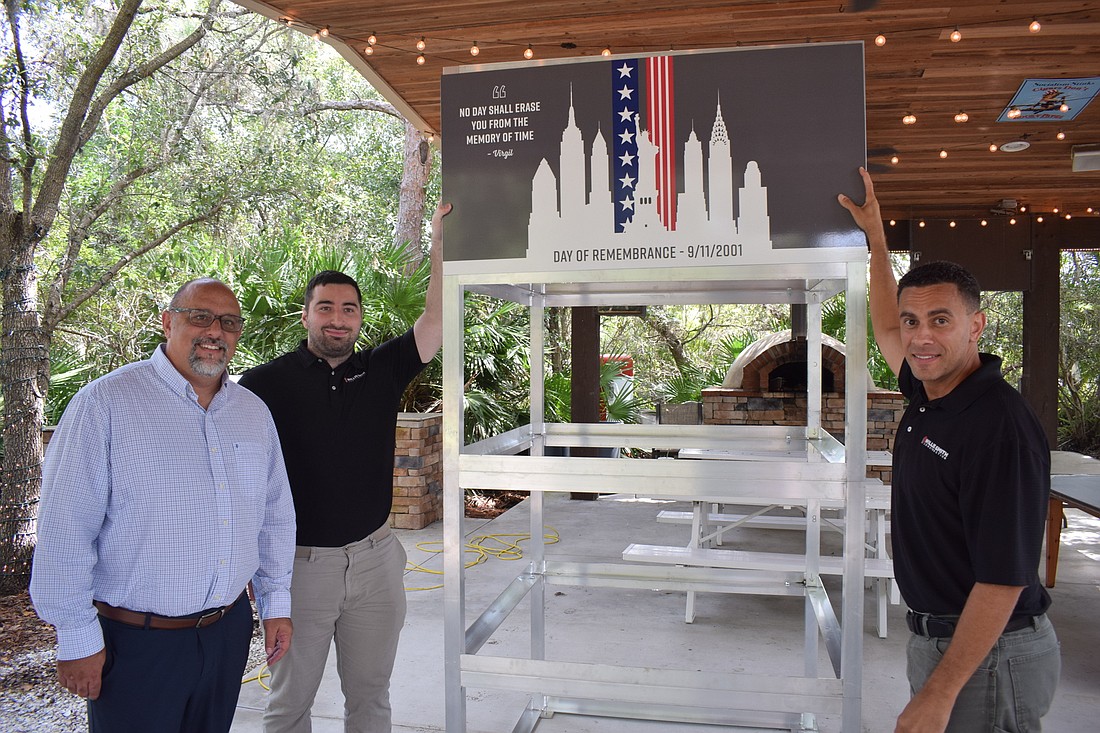- April 3, 2025
-
-
Loading

A month after Brandon Gundrum had moved to Florida, he remembered being in class at Tara Elementary School when news of the World Trade Center attacks began to emerge.
He was only 5 at the time, but Sept. 11, 2001 made an impact on him he never will forget.
"I remember a lot of people were panicking," he said of the moment. "Then we started getting calls from family (from his former home of Rochester, New York)."
Twenty years later, Gundrum was handed a little project that came across his Willis Smith Construction desk.
Gundrum, who works in pre-construction, was asked to find subcontractors and the materials to build a 4-foot-by-4-foot wide cube that would be 8 foot high. On all four exterior sides of the cube would be chalk boards for people to write down their memories and feelings about 9-11.
The cube would be placed adjacent to Lakewood Main Street beginning on Sept. 2 and would remain there 10 days. Willis Smith Construction and Fawley Bryant Architecture, which just finished working on Waterside Place together, would donate the cube to help lead up to the 9/11 Day of Remembrance memorial Sept. 11 at Main Street at Lakewood Ranch.
"I thought it would be a straightforward task," Gundrum said. "But I knew it needed to be placed outside during the rainy season, and that it would be hot. The cube would need to be durable, and be able to last. Getting the right chalk boards was important because you don't want to cut into something and have it shatter like glass."
Gundrum began to reach out to local subcontractors to build the cube, and the answer was the same. No. Everyone was buried with work. He widened his range from Tampa to North Port. The answer was the same.
"I was sure someone would want to take it on, but I found out that we would need to have each individual piece made and we would have to put it together. We had to line up all the materials coming to us at the same time and everything had to be exact measurements."
Willis Smith Project Manager Angel Ortiz Jr. could see the little cube project was turning into a rather difficult assignment.
That didn't matter.
Ortiz grew up in the Harlem section of Manhattan, and his father, Angel Ortiz Sr., was working at his office on Fifth Avenue when the planes struck the World Trade Center towers.
"It hit close to home," Angel Ortiz Jr. said.
Ortiz Jr. was working the end of the night shift on Sept. 11, 2001, renovating a Publix in Cape Coral. Knowing his father wasn't far away from the World Trade Center, he immediately tried to call, without any luck. Fortunately, his dad reached him soon afterward to tell him he was OK.
He will never forget those anxious moments, and so the cube took on major project status, even if he had to put other duties aside.
"The construction time frame was difficult," Ortiz Jr. said. "It is right at the beginning of school, and chalk boards are hard to find."
Ortiz Jr. had to find signs that could be placed at the top of the cube on all four sides. That wasn't easy with a two-week time span for completion.
He eventually found a company in Cary, Illinois, that sold chalkboards. Ortiz explained his problem and billyBoards came through with the needed material.
Then he needed welding done on the cube's frame. He went to Icon Welding and Fabrication of Sarasota.
Icon Welding owner Mike Norrito told him, "I want a piece of this."
He got a hold of Bill King of King Signs of Sarasota and explained the rush. King came through as well.
"I had to ask for favors," Ortiz Jr. said.
Willis Smith carpenters Steve Redhead and Rick Baker were pulled off jobs to help with construction. They had to figure out how to anchor the cube, which would be attached to a base.
Involved in the entire process was James Hugglestone II, a senior project architect with Fawley Bryant Architecture. After being told the concept, he designed several iterations. At first, Hugglestone was asked to design a cube that could be dismantled and folded away. Ultimately, the aluminum box frame cube was made more rigid, but still could be disassembled and used again.
Hugglestone knew there would be material constraints because of the pandemic, but like Ortiz, he thought the cube's purpose was too important to drop the project.
He was working in Tampa on Sept. 11, 2001 and he remembers the shock that affected everyone.
"It became a not very productive day," he said.
He knew the cube project "would have heartstrings" attached to it.
"I can't wait to see it (on the street)," he said. "It will be enlightening, emotional."
Eventually, the cube became a $5,000 project even with all the labor donated. Several companies and individuals had a hand in making it happen at a difficult time.
"I would tell someone I needed it in two weeks and they would say, 'So I need to stop my production line?'" Ortiz Jr. said. "I would say, 'Yes, it's 9-11.'"
Gundrum said people of all ages will be able to take something away from the cube.
"The impact is just as great whether you were born at the time, or not," he said. "Everyone has family, and a lot of families were impacted."